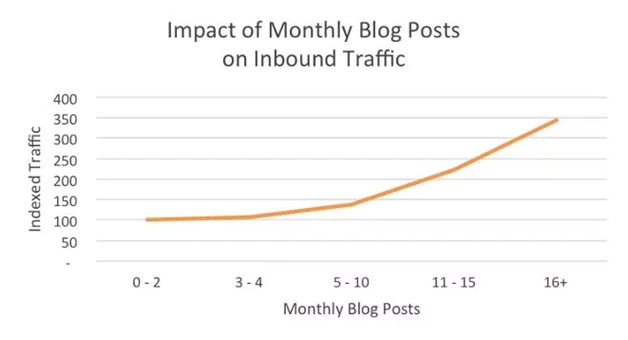First things first. Why is blogging important for brands? Whether you’re a B2B or B2C marketer, you’ll need to include content marketing services as an integral part of your brand marketing strategy. The Content Marketing Institute (CMI) reports that 91% of marketers use content marketing to promote brand awareness and 76% opt for blogging to drive traffic to their brand website. It’s needless to say that nearly 24% of marketers are not taking blogging seriously but, should they?
Here are 4 broad and simple reasons why blogging is the “Holy Grail” of content marketing for brands.
1. Drives Search Traffic
Do you want more traffic to your website? Duh, yes of course. Well, that’s your first biggest reason to start blogging.
Very Simply Put –
Blogs+SEO+Social Media = Traffic and leads.
Coming back to blogs, if you are promoting your business through digital marketing, then your business blog is your largest ammunition. HubSpot has already shared facts to prove this.
 This clearly shows that the more blogs that you post per month, the higher traffic you get. When there is more traffic to the website, there is also naturally a higher chance of getting more leads. You can either post new blogs or re-purpose your existing blogs by adding new content to increase the organic traffic to your website by 106% according to HubSpot.
This clearly shows that the more blogs that you post per month, the higher traffic you get. When there is more traffic to the website, there is also naturally a higher chance of getting more leads. You can either post new blogs or re-purpose your existing blogs by adding new content to increase the organic traffic to your website by 106% according to HubSpot.
For instance, HubSpot posts 200 new posts every month which results in 54% lead generation while repurposing its existing blogs results in 46% lead generation. Isn’t that enough proof to take your business blog more seriously?
This is because your buyers are constantly looking for unbiased, relevant, and insightful content online that can educate and empower them to make the right purchase decisions. On Brand states that building an audience is more valuable than direct sales for over 70% of brand managers. Vlogging and blogging help build a community of audiences for your brand, organically. There is a higher probability of them converting into loyal customers over a certain period of time.
Let’s be practical! Most of you would have googled for the latest mobile phones in the market at least once in the past and then, read through a number of buying guides on the CNET website or other websites before buying them. It’s a well-known fact that a buyer will research, analyze, and finally, is more likely to decide on a brand that has well-researched, good quality content in that specific field since it showcases the brand as a pioneer in its field.
That’s exactly what a good blog does. It informs and inspires the buyers to zero in on the right brand in the market for their needs and wants. It educates your buyers with how-to guides and narrates your customer success stories to persuade them to buy from your brand rather than from your competitors.
Blog also feeds your social media and keeps it going. You are not only increasing your brand’s social reach, you are also earning new traffic through social to your website.
Also, here is a quick fact to digest. How many times do you add pages to your website? In most cases, people add pages to their website once in a year. Now think of your blog. Every post you put there is a new page indexed for your website, which basically means it’s a chance for you to get traffic to your website and increase your probability of ranking for that particular topic.
Also Read: Types of Content to Get More Traffic to Your Blog
Hint: Analyze the list of search queries from your target customers using SEO research tools like SEMRush or Moz to develop the right content for your brand blog.
Something to remember: It’s also important to note here that just creating the blogs and publishing them will not do. You will need to optimise the blogs with the right keywords and distribute them properly to get more reach. Here is where SEO services play their part in helping the blog rank for relevant keywords.
2. Builds Domain Authority
Domain authority (DA) is a ranking metric that indicates how authoritative your domain or website is based on several factors such as quality of content, social signals, and other SEO best practices.
You’ll need to spend a considerable amount of time and effort to create, distribute, and promote exhaustive content that will benefit your potential customers and convert them into loyal clients over the long-term.
The DA of a website can range between 1 to 100. The higher your site’s DA, the better chances you have of ranking.
You can check the DA of your site with a tool called Open Site Explorer.
Ideally, DA score above 60 for a domain reflects an excellent domain authority with a high probability of search ranking for that particular website. Likewise, a DA score below 40 indicates poor domain authority and requires a well-planned content marketing strategy for a higher score.
Blogging is one of the major contributors to establishing the domain authority for your brand. There are a number of content types such as podcasts, webinars, and animated videos to promote your brand across the customer journey. Your brand blog will score high among other brand-building content types for the simple reason that it’s more comprehensive and clear in communicating your brand authority.
Hint: Explore guest blogging opportunities on trusted websites for your brand.It will improve your domain authority and overall search engine ranking.
3. Generates Leads
Can your blog influence your customers to make a purchase decision? Do your blog visitors make a product/service inquiry online/offline? The objective of publishing ‘n’ number of blog posts in your brand blog is to build brand relevance and brand authority. But, the goal of each blog post content is to initiate conversion for your brand from leads from customers through Call To Action (CTA).
Yes, blogging is but a piece to the lead generation puzzle for brands in the digital marketplace. You’ll have to capture leads on your blog page through either gated content like e-books and whitepapers or newsletter signups. However, it incurs minimal to zero cost to create and publish a blog with better returns in the long term.
Also Read: Why Great Brand Stories Need Videos In This Age?
You’ll never know how the blog post that you published about a year ago on immunity-building food recipes will interest the readers and initiate inquiries for your recipe book a year later due to the pandemic outbreak and the resulting lockdown.
Hint: So, simply create relevant, good quality blog posts and keep updating them now and then with key takeaways to increase their shelf life. A blog is a great lead generation tool and requires low investment.
4. Maximize Long-Term ROI
You’ve added a relevant call-to-action at the bottom of every blog post that you publish to help your brand generate more leads. Now, your readers can choose to take a specific action like downloading an e-book or subscribing to a newsletter once they reach the end of your blog post to stay connected with your brand. It’s an important step to optimize your business blog for better Return on Investment (ROI).
Return on Investment (ROI) = Return from an investment/cost of the investment
Brands invest in a business blogto attract, interest, convince, and persuade customers to make a purchase.Though blogging requires minimal investment compared to developing other content types like videos and podcasts, it can generate more leads with a higher conversion rate over the long-term through the “compounding” effect.
This data published by Hubspot shows how compounding blogs (blogs that offer immense value to the customer) generate traffic over time.
The clearly proves that the shelf-life of a well-written blog post extends far beyond a few days or weeks from its publishing date. Search engines, social media posts and newsletters are few of the many channels that can help increase the traffic to your blog posts on an ongoing basis even after a year from the date of publishing the blog post. Relevance and quality of content can keep your blog posts evergreen with higher search rankings and higher conversion rate which maximizes long-term ROI for your business blog.
It’s often quoted that an average buyer’s interest in long-form content is declining at present while the need for short-form video content and animated GIFs are on the rise. Diversify the content types based on the context but never lose sight of your brand blog’s long-term ROI in the content marketing game. A good mix of blog posts and other content types will get your brand way ahead of its competition.
Conclusion
Distribute and conquer! Content marketing is about sharing your branded content across different channels including social media networks, Q&A forums, and influencer networks. You can create a wide variety of content to promote your brand among your target customers but still, it’s a well-known fact that business blogs yield maximum returns with minimal investment when compared to other content types.
Yes, blogs are SEO-friendly, promote domain authority, generate leads, and boost long-term ROI for brands.
So, when it comes to getting traffic for your business, blogging is a great channel and you must start yours today.






